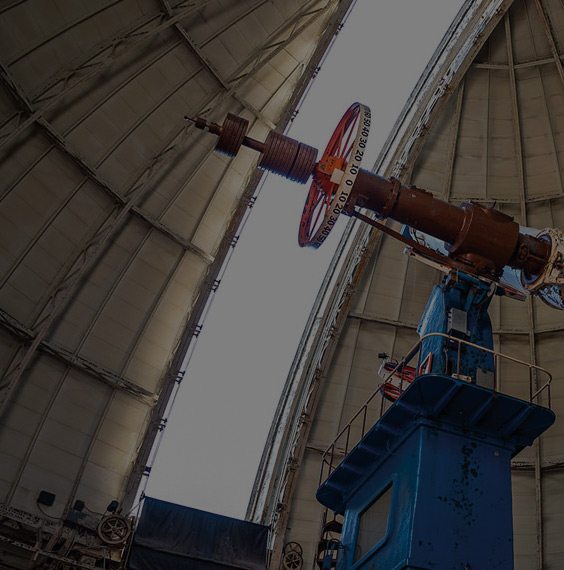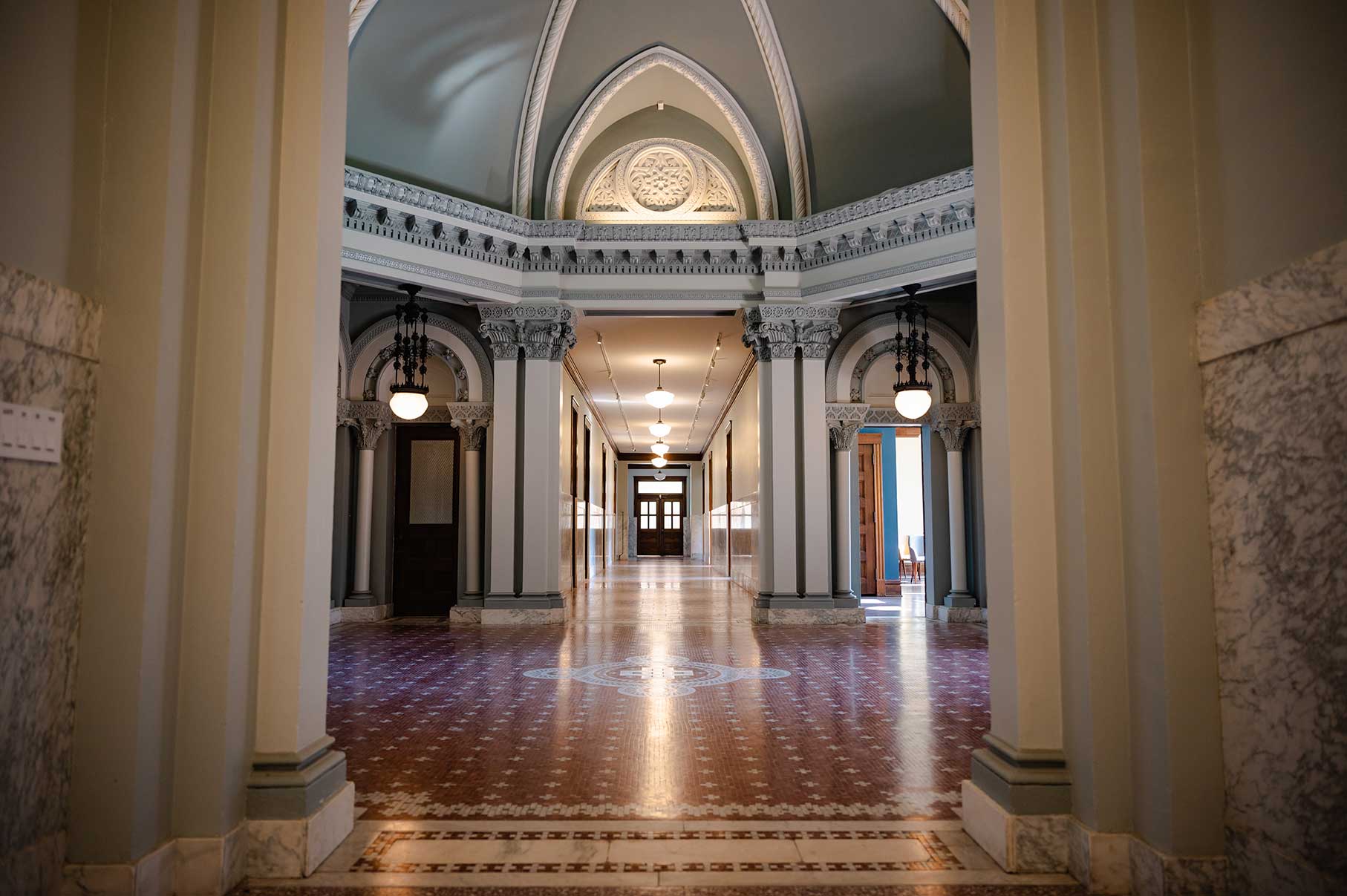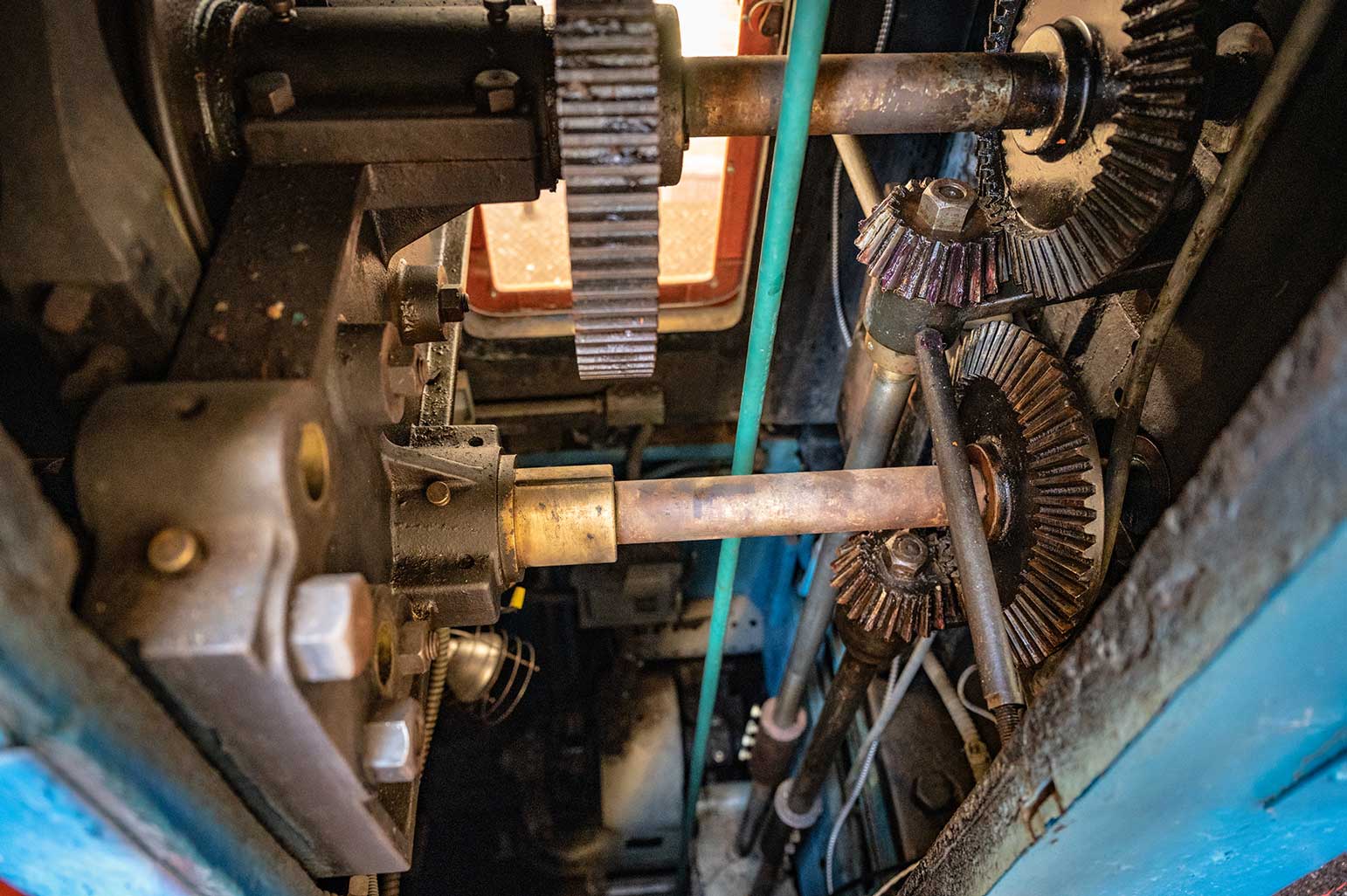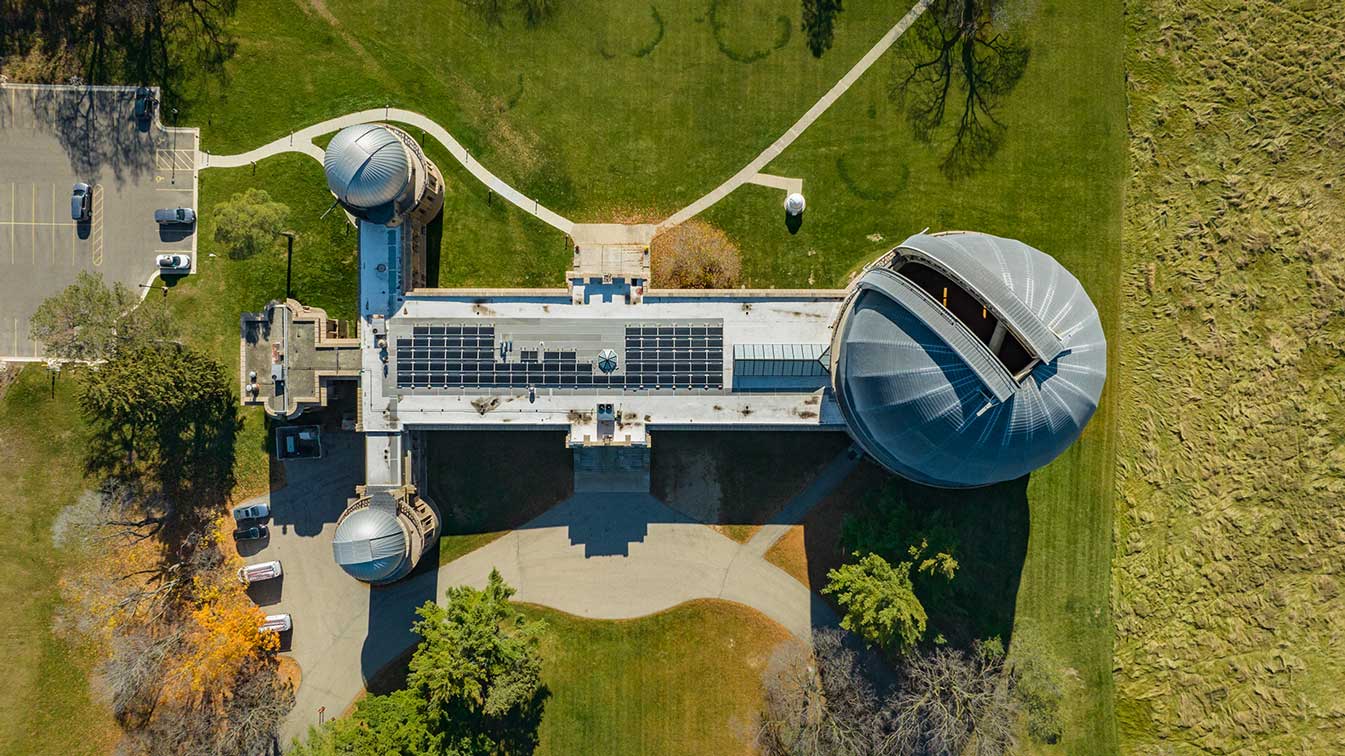

Restoring World's Largest
Refracting Telescope
Yerkes Observatory: Restoring the World’s Largest Refracting Telescope
By Grainger Editorial Staff 2/7/23
When Dr. Amanda Bauer first uncovered the 125-year-old Great Refractor telescope at Yerkes Observatory after it had been inactive for nearly four years, she was unsure what she would find.
Built by the University of Chicago in 1897 in Williams Bay, Wisconsin, Yerkes Observatory is home to the world’s largest refracting telescope and famous astronomers like George Ellery Hale, Edwin Hubble and Carl Sagan worked and studied there.
But as newer technology emerged the Great Refractor became less relevant, and the university closed the observatory in 2018. A non-profit formed by residents in the nearby Lake Geneva area took control, and in 2020 that group, Yerkes Future Foundation, embarked on a $20 million renovation effort. In addition to reviving the giant telescope – which Dr. Bauer found functional but in need of work – those renovations include a host of electrical, plumbing, HVAC and landscaping projects designed to restore viability to this historic landmark.
A New Era for a Historic Landmark
Yerkes assembled a team of architects, landscape designers, artisans and tradespeople to complete its initial restoration efforts. From masons restoring the decorative 19th-century terracotta stonework to contractors replacing the roof and skylights, many workers are local professionals and contractors. They are excited to be part of the community effort to revive this historical treasure.
Adams Power, an Elkhorn, Wisconsin-based contractor specializing in electrical, HVAC, plumbing and smart tech, is leading many of the restoration efforts. Some of the work includes:
- Installing an all-new electrical system
- Rewiring the dome to bring it up to modern standards
- Retrofitting all lighting to LEDs
Other restoration highlights include building new restrooms to meet ADA standards and installing a new HVAC system to air-condition the building for the first time. Adams Power also upgraded the lighting in the parking lot and installed new electric vehicle charging stations.
Tim O’Brien is a lead journeyman electrician at Adams Power, and he said the biggest challenge in restoring Yerkes Observatory has been the building itself. “With three-foot thick walls made out of solid brick and floors that are two-foot thick … making sure we weren’t drilling through this 150-year-old marble and causing any more problems to the building” has been a major concern, he said.
To help preserve the integrity of the building, including original lighting fixtures from the early 1900s, contractors had to fabricate brackets to retrofit the fixtures in the newly renovated rotunda. Fortunately for them, the observatory has a fabrication shop in the basement where contractors could utilize a lot of the equipment to make the brackets, boxes and help salvage other necessary parts.
Since the dome housing the Great Refractor originally ran on DC power, the main dome's power had to be converted via a rectifier. “The rectifier takes up a lot less space and is more reliable turning the AC power into DC power for the elevator floor and the dome,” said O’Brien. Adams Power also added a whole house generator in case the power goes out.
Bringing the Telescope to Life
Before Dr. Bauer arrived, the Great Refractor telescope had been closed as Yerkes Future Foundation was repairing the building infrastructure that had suffered from several years of deferred maintenance and repairs. The brickwork restoration on the main cathedral-like dome housing the Great Refractor was completed just a month before Dr. Bauer arrived in July 2022. Her first task as Yerkes’ Deputy Director and Head of Science and Education was to determine if the Great Refractor was still operational, understand how it functioned and learn how to effectively work with the historic equipment.
“Luckily, I didn’t find anything completely broken, but every time I use it, there’s something different or a different noise in the dome. And you just have to be flexible with what you’re hearing and always if you are in doubt, then you stop, and you make sure that everybody’s safe,” said Dr. Bauer.
To her surprise, the telescope and its 60-foot-long metal tube were still balanced enough that they could be moved with just her hands. However, while the telescope was operational, it was difficult and stiff to move. Over the first month, Dr. Bauer had to determine whether the stiffness was due to a ground-down gear and figure out all the places the telescope needed to be greased and oiled.
Since there is no owner’s manual for a one-of-a-kind telescope, Dr. Bauer has been relying on past engineers and facility staff to help fill in the knowledge gaps.
Unlike more modern equipment, there is no computer program to help operate the telescope. “There is a button, knob or gear you have to physically find and trace it to its connection to understand how it works,” said Dr. Bauer.
Staying flexible and alert to potential issues is an important part of working with such historic equipment. During one of Dr. Bauer’s first lessons on operating the telescope with a former facility director, she discovered they were stuck when she went to lower the floor. They had moved the dome floor up to inspect the system components, making it difficult for them to safely find a way out. Since the main dome housing the Great Refractor was still being restored, Dr. Bauer had to find a hole in the plastic covering to climb out and find someone to help rescue the former director. Eventually, they got the DC power back to help lower the dome floor. Inadvertently, she had discovered an issue with the new rectifier that hadn’t been properly tested and needed to be replaced.
Dr. Bauer said one of the first priorities was to refurbish and rewire the dome movement and elevator surrounding the Great Refractor to make it safe, reliable and true to its time. Due to wear and tear, there were some spots in the dome where the power was not connecting.
“What if we can’t close the shutter and we’ve got a storm coming? We need to protect the equipment. Or what if the floor gets stuck and we have visitors or people trying to look through the telescope?” said Dr. Bauer.
Dr. Bauer intends to restore the Great Refractor as close to its original glory as possible to highlight what the astronomers were able to achieve in 1897. Inspired by the boats on nearby Lake Geneva, she plans on restoring the telescope to its original brass finish and something truer to its time by removing the collar and some of the components that are no longer functioning. The last major refurbishments of the telescope were done in the late 1960s, when caretakers added a blue collar and repainted the original brass components in a blue and orange color scheme.










A 10-Year Project
Inside the massive blue column pier that supports the Great Refractor are two enormous motors that turn the telescope around the axis originally powered by the DC motor. Unfortunately, during a closer inspection, Dr. Bauer noticed that the two large gears inside the motor were completely stripped. She is trying to find some experts to help assess if the gears can be fixed since they help power the big motions of the telescope.
One of Dr. Bauer’s long-term refurbishment goals is getting the DC motor operational again, which will assist with observing and help with some of the deferred maintenance. She will also be cleaning the lens of the telescope, which hasn’t happened since the observatory reopened.
“Repairing the original DC motor in the support column would restore the original movement of the telescope and help recreate the magic of what they were doing at that time as opposed to putting in computer systems that would bring it to modern day,” she said. Other refurbishment plans include updating equipment for the facility's two reflecting telescopes to highlight the most modern technology available to today’s astronomers.
Full restoration is projected to take approximately 10 years. However, Yerkes Observatory reopened its doors in summer 2022 for guided tours of the Great Refractor, also highlighting the building’s impressive architecture and the landmark’s restoration efforts.
Sustainable Preservation Efforts
Along with the restoration of Yerkes Observatory’s 19th-century architecture and grounds, the foundation is working to make it more sustainable. The entire 60,000-square-foot building is running off solar power thanks to 96 newly installed solar panels on the roof.
“The building and dome are now producing over 18,000 kilowatts but only using about 2,000 to help lower operating costs,” said O'Brien. The generated electricity is then sent to the inverters in the basement and back to the grid. In addition to a whole house generator, battery backups were also installed. This way, if the power ever goes out in the evening, every light and outlet would still work.
“The backup batteries last between 5-6 hours, providing ample time to operate until the sun comes up,” said O’Brien. The generator and battery banks allowed the electricians to bring the old knob and tube wiring up to code without having to add more modern touches that weren’t warranted.
In addition to restoring the building and sprawling grounds originally designed by the Olmsted firm – co-designer of New York’s Central Park – the Morgan House near the observatory is also being restored. The Victorian home, built in 1897, was once home to astronomer William Morgan (who discovered the spiral shape of the Milky Way) and his family. Yerkes plans to use the property to host a new generation of astronomers, scientists and artists while working at the observatory.
“One of the fun things about working at Yerkes is you find things all over the place,” said Dr. Bauer. “Every day, I open a cabinet or a closet and discover something, and then try to figure out what it is. It could be historical artifacts, glass plates that the telescope took or original mechanical drawings for one of the instruments."
The Great Refractor Telescope: A 19th-Century Engineering Marvel
Weighing about 82 tons, the Great Refractor is the world’s largest refracting telescope. The University of Chicago transferred ownership of Yerkes Observatory to Yerkes Future Foundation in 2020, leading to plans for restoring the remarkable telescope for research and public viewing.
- The 64-foot barrel of the telescope weighs six tons and has two 40-inch diameter lenses.
- The Great Refractor’s mount and barrel were featured at the 1893 World’s Fair and assembled at Yerkes Observatory in 1897.
- The Great Refractor is supported by a concrete, brick and steel column extending 40 feet into the ground to help protect it from seismic changes.
- To help compensate for Earth’s rotation, the telescope pivots on a mount on a pier measuring 65 feet from its base. A small motor on the mount allows the telescope to stay fixed on an object in constant motion.
- The telescope features achromatic lenses instead of mirrors used by more modern reflecting telescopes. When the Great Refractor was completed, astronomers switched from refracting to reflecting telescopes, leading to the Great Refractor remaining the world’s largest refracting telescope.
- Using the Great Refractor, Yerkes astronomers revolutionized deep-sky astrophotography.
See how the Great Refractor works and learn more about its incredible legacy.
The information contained in this article is intended for general information purposes only and is based on information available as of the initial date of publication. No representation is made that the information or references are complete or remain current. This article is not a substitute for review of current applicable government regulations, industry standards, or other standards specific to your business and/or activities and should not be construed as legal advice or opinion. Readers with specific questions should refer to the applicable standards or consult with an attorney.






